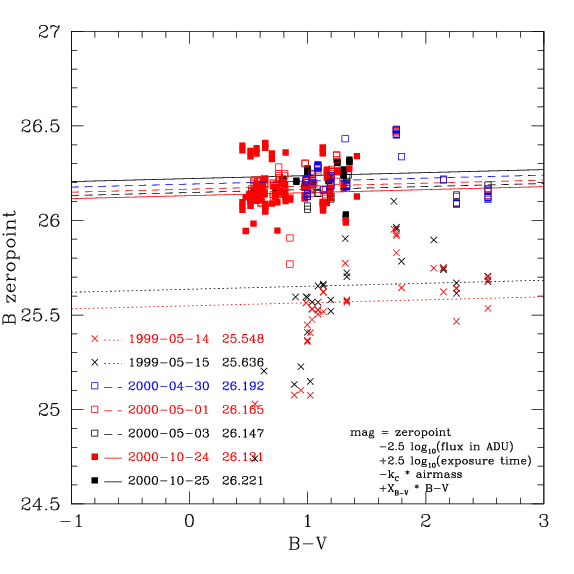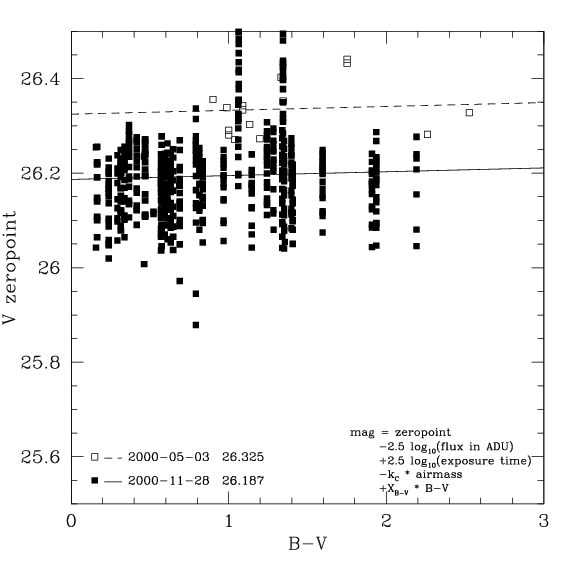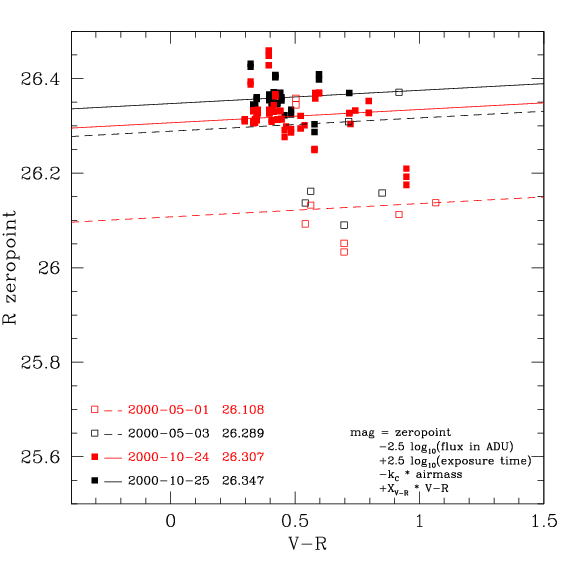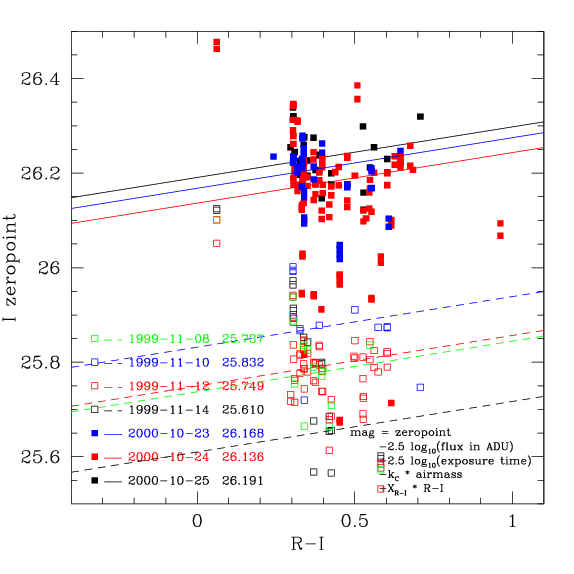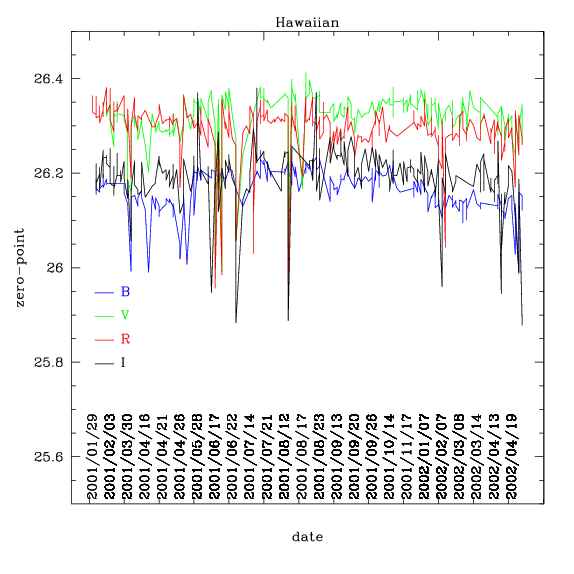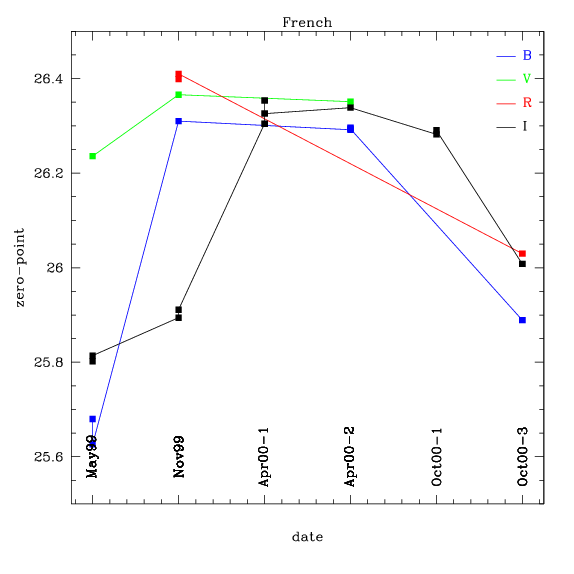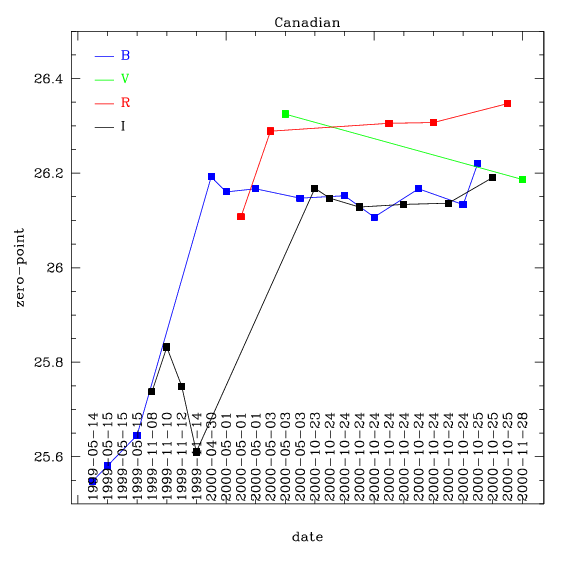|
By querying the CADC website for observations of the Landolt
standard star fields taken during the VIRMOS runs, a comprehensive
list of calibration observations was drawn up. This list was cross
referenced with the detrended data currently on the TERAPIX disks.
By no means all of the data taken is on the disks. Although all this
data is in fact available from CADC, it is in raw form. In order
to use it, it would have to be detrended, a time consuming process.
Also, the volume of data is considerable, making transfer times
prohibitive.
The detrended data was calibrated astometrically with the AstroGwyn pipeline
in an automatic fashion. SExtractor was run on the images to produce
photometric catalogs. The objects in this catalog were cross-referenced
with the catalog of Landolt standard stars to produce a list of
observations. The list contains the exposure time and airmass information
taken from the header, the instrumental magnitude and the
A number of the standard star observations were taken with the
telescope delibrately out of focus, to avoid saturating the detector
on the brighter stars. These images can not be processed in an
automatic way and were therefore ignored in the interests of
expediancy.
Further any SExtractor catalog entry with a non-zero flag was omitted.
This avoids staturated stars as well as any other peculiarities.
Once full list of standard star observations with is compiled,
the zero-points were computed.
The zero-points were determined by the following two methods
- Zero colour zero-points:
- The colour terms and extinction coefficients from the Elixir pages is assumed.
These data are repeated in the table below.
- The instrumental magnitude, -2.5*log10(flux) is corrected for:
- Colour term: this is based on the Landolt standard colours NOT the instrumental colours
- Exposure time: 2.5*log10(exposure time in seconds)
- Airmass:
Thus we have:
mag_instrumental = -2.5*log10(flux)
mag_instrumental_corrected = -2.5*log10(flux)
+ colour_term * colour
+ 2.5 * log10(exposure time)
- (extinction coefficient) * (airmass)
- The difference between the correct instrumental magntiude and the magnitude of the Landolt standard
gives one measure the zero-point.
zero-point = Mag_Landolt - mag_instrumental_corrected
- For a given night, one takes the median of all the zero-points calculated.
- Since the procedure takes the colour term into account it gives the zero-point
at zero colour.
- Median colour zero-points: In this procedure, the colour term is ignored.
- The instrumental magnitude, -2.5*log10(flux) is corrected for:
- Exposure time: 2.5*log10(exposure time in seconds)
- Airmass:
Thus we have:
mag_instrumental = -2.5*log10(flux)
mag_instrumental_corrected = -2.5*log10(flux)
+ 2.5 * log10(exposure time)
- (extinction coefficient) * (airmass)
- The difference between the correct instrumental magntiude and the magnitude of the Landolt standard
gives one measure the zero-point.
zero-point = Mag_Landolt - mag_instrumental_corrected
- For a given night, one takes the median of all the zero-points calculated.
- Since the colour term is ignored, and since (in general) there really is one, this
procedure gives the zero-point at the median colour of the standard stars used in the
calculation.
The following table gives the extinction coeffincients and colour terms from the Elixir web page.
| Filter | Extinction
coeffecient | Colour
term | Colour |
|---|
| B | 0.15 | 0.016 | B-V |
|---|
| V | 0.12 | 0.008 | V-R |
|---|
| R | 0.09 | 0.028 | B-V |
|---|
| I | 0.04 | 0.107 | R-I |
|---|
|
